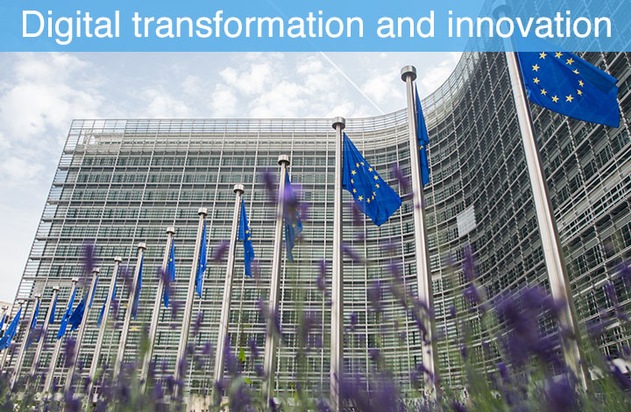Digital transformation and innovation in Europe
Smartphones, high-speed Internet and new research initiatives - the ongoing process of digitisation brings with it profound changes in many sectors. This is also true for the European Union: Technological innovations not only affect the daily lives of millions of people, but also have the potential to revolutionise entire markets. As a result the digital realm is becoming an ever more important political playing field for the EU.
Transformation through interconnection: the topics digitalisation and innovation have been on the European Union's political agenda since 2010. By 2020, the bloc is aiming to achieve a fair, open and secure digital environment for every citizen of its member states. It also wants private businesses to benefit, for example, from the increasing innovative capabilities of European science and research.
The internal market and digitisation
The implementation of the Digital Single Market, which aims to merge the national markets of the individual member states' into a single one, takes centre stage on the EU's agenda. The aim is to facilitate easy consumer access to digital goods and services. Online customers will have the same statutory rights as they would in stationary retail.
The EU also wants to fully exploit the growth potential of the digital economy. As a result, the bloc is hoping to create several hundred thousand jobs and an increase in economic output of more than 400 billion euros. In this context, European institutions are also working on issues such as a redraft of European copyright or cybersecurity laws.
Another major political priority is the expansion of the broadband network: the EU is planning to give its approximately 500 million citizens easier access to the Internet through new cost reduction rules, updated guidelines to promote broadband deployment by member states and a revision of its telecommunications directives.
Innovation and digitization go hand in hand: particular emphasis is placed by the European Union on key technologies such as robotics, which are at the intersection between digitisation and research.
Cross-border innovation
One of the key objectives of the EU's innovation policy is for member states to invest three percent of their gross domestic product in research and development by 2020. The bloc is hoping to create up to 3.7 million additional jobs in this way. It is also projecting an increase in annual GDP of almost 800 billion euros.
The research and innovation program "Horizon 2020" is the EU's central instrument for public research funding. Under it, around 80 billion euros worth of funding are made available for top-level research and investments in key technologies between 2014 and 2020. The program also specifically supports research into approaches to tackle societal challenges such as climate change or demographic change. The measures are coordinated by the European Research Council. From 2021, the program will be replaced by "Horizon Europe". For the years 2021 to 2027, the successor program will make available frrunds amounting to 100 billion euros.
The EU is also planning a European research area to better integrate scientific resources across the member states, thereby strengthening cross-border research.
Europe's innovation leaders
Since 2010, the European Commission has published a European Innovation Scoreboard, listing the most innovative European countries and providing an outlook on the bloc's innovative capabilities. In 2018, Sweden was named the most innovative member state, based on 27 indicators in four categories. Denmark followed in second place.
This interactive map shows how innovative the remaining regions in the EU are: http://dpaq.de/4cEsC
Since 2010, the degree of innovation in the EU has risen by 5.8 per cent, meaning that the ability to innovate in the EU is at a similar level as in other western countries. The areas with the highest gains are broadband access, human resources and the increased attractiveness of the scientific landscape.
The role of the European Parliament
As co-legislator, the European Parliament plays an important role with regards to digital and research issues. Not least, the EP supports the continent as a centre for research and innovation through its right to a say in the budget negotiations. The EP is in favour of ensuring equal access to the Internet and full data protection for all EU citizens - issues that are important to many people independent of the European elections.
[Attention: These images are intended exclusively for editorial use in connection with the current coverage and may be used only when using the copyright notice "Photo: dpa".]


